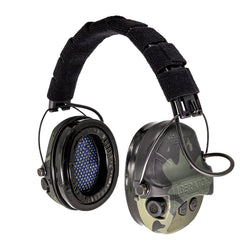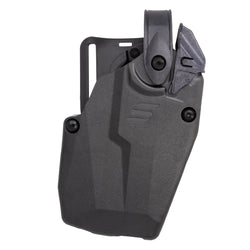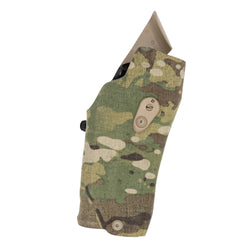The branches of the U.S. military can rarely agree on anything, much less a uniform. It seems like everyone is moving towards some form of Multicam camouflage (except the USMC), and for the first time in decades, the military will largely look the same. The last time that happened was when the United States adopted the U.S. Woodland camouflage pattern, also known as M81.
M81 Woodland was never an official name. The official designation is U.S. Woodland camouflage, and it entered service in 1981, which is where the “M81” moniker comes from. Woodland was the standard Battle Dress Uniform (BDU) camouflage for U.S. military forces for decades, only replaced as each branch decided to digitize camouflage.

The Marine Corps started the digital camo trend with MARPAT, and the Army, Air Force, and Navy quickly followed, each adopting its own pattern with varying degrees of effectiveness. Even though we now have all these high-tech digital and transitional designs, the classic M81 Woodland camo remains popular.
Today, we’re going to look at what makes M81 effective, its history, and why “God’s Plaid” remains an icon of American tactical fashion.
What Is M81 Woodland Camo?
M81 Woodland is remarkably simple. It’s a mixture of black, green, brown, and khaki shapes arranged in amorphous patterns. Those with imaginations can stare at a piece of M81 and find dinosaurs, sharks, and butterflies in the blobs that make up this distinct design.
The various colors are designed to replicate a temperate forest. The pattern plays on shadows and natural colors to disrupt outlines and camouflage human shapes. It breaks up the head-and-shoulder silhouette and reduces the visibility of the wearer at distance.

M81 Woodland scores high when it comes to excelling in the basics of a camouflage pattern. It’s not quite universal, but it proved successful in multiple types of terrain, from temperate forests and jungles to arid environments with at least some greenery present. The mass adoption of the pattern and its modification is a testament to its camouflage effectiveness.
M81 vs. ERDL: How the Pattern Evolved
1981 saw the birth of the DeLorean, the F-117 Nighthawk, and the U.S. Woodland camouflage pattern. Vietnam was in the rearview mirror of the United States military, and planners were looking to create a modern combat uniform. Combat veterans from Vietnam pushed hard to adopt a disruptive pattern to better conceal soldiers.
In Vietnam, troops had worn the ERDL camouflage pattern, first developed in 1948. The colors and general layout of ERDL were adapted into M81, with modifications to meet new battlefield needs.

ERDL excelled in close-range jungle warfare but lacked effectiveness at longer infantry engagement ranges. With the Cold War heating up, the U.S. military was preparing for a potential war in Europe. That battlefield meant wide-open plains and fields pockmarked by European temperate forests. The solution: use the ERDL as the base pattern, and enlarge it by 60 percent.
Simply put, the blobs got bigger. There was a little more to it than that, but blowing up the pattern extended its camouflage effectiveness up to 350 meters. Beyond 350 meters, the pattern blends into a monotone design.
Everything was Woodland: Widespread adoption
The U.S. Army adopted U.S. Woodland camo first, and the Navy, Marine Corps, and Air Force followed. And they adopted it hard. Everything was Woodland.

From HMMWVs and body armor to MOPP suits, everything got the Woodland finish. By the time the Global War on Terror kicked off, everything was woodland. This resulted in soldiers and Marines famously being issued Woodland camouflage gear in the deserts of Iraq.
Even in 2008, my initial issue of body armor featured M81 Woodland attachments, namely the crotch and neck protection. Woodland was everywhere, and it was one of the rare times all branches of the U.S. military wore the same camouflage pattern.

Even after the great split into various digital camouflage uniforms, the Woodland finish stuck around here and there. My cloth drum was M81 woodland, and I carried it until 2013. A new generation of combat shirts, plate carriers, and pants emerged in the familiar green-and-brown pattern.
The Revival of M81 Woodland Camo
Even with MARPAT and Multicam seeming to dominate the future of camouflage amongst military forces, U.S. Woodland never went away. In fact, in the civilian and tactical gear market, it’s incredibly popular. Not only is it effective, but it’s stylish.
There is something deliciously old-school about this traditional camo pattern. It’s aesthetically pleasing to the eye. Look at it! It’s just plain cool.
Not only is it effective and cool, but it’s also separated from the modern U.S. Military. You can wear it and not feel like you’re trying to steal valor.

This has led to a cottage industry of Woodland-patterned gear. Even things that don’t need camo, like the Incog X AIWB holster, rock the woodland finish simply because it looks cool. Black, Multicam, grey, and FDE have become common. M81 stands out. That’s why it has earned the nickname “God’s Plaid” in the firearms community.
From holsters and slings to boots, belts, and even underwear, M81 has become a style statement in addition to being a functional camo. M81 won’t die, and by god, I don’t want it to.
There are plenty of stylish camouflages, but the M81 is stylish and functional. Plus, it helps that surplus BDUs are cheap and widely available. If your holster and boots don’t match your pants, then what’s the point?
Safariland and the Return of Woodland
Safariland has embraced the M81 Woodland pattern across numerous holsters and gear. The Incog X rig now comes in Woodland, as does the brand-new Gravity holster. Limited editions of Safariland’s Level 3 duty holsters have also appeared in Woodland — and you never know when more are coming back.

M81 isn’t fading away anytime soon. It’s stylish, effective, and deeply tied to American military history. For veterans, shooters, and gear enthusiasts, Woodland camo offers both nostalgia and functionality.
M81 Woodland Camouflage FAQs
When was M81 Woodland adopted?
M81 Woodland camouflage entered U.S. military service in 1981 as the standard Battle Dress Uniform (BDU) pattern. It remained the dominant camo for decades before digital designs replaced it.
What camo pattern did M81 replace?
U.S. Woodland evolved directly from the earlier ERDL pattern, which was used during the Vietnam War. M81 enlarged ERDL’s design to improve effectiveness at longer distances.
Why is it called M81?
The official name is “U.S. Woodland,” but the shorthand “M81” comes from the year it was adopted — 1981. The “M” stands for “Model.”
Why do people call it God’s Plaid?
In the firearms and tactical community, M81 Woodland has earned the nickname “God’s Plaid” because it’s both stylish and effective. It blends functionality with a timeless, old-school look that stands out in today’s sea of digital and Multicam patterns.









